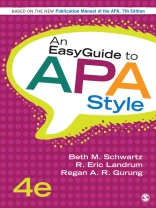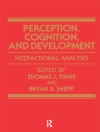Winner of the 2022 Textbook Excellence Award from the Textbook & Academic Authors Association (TAA)
This clear and concise book demystifies the process of writing in APA style and format.
Fully updated with content from the Seventh Edition of the Publication Manual of the American Psychological Association, An Easy Guide to APA Style, Fourth Edition identifies common APA style and formatting mistakes, how to avoid them, and helps students become better writers and communicators of psychological science. Written in a conversational style to make the task of learning how to write more enjoyable, this guide helps students navigate the maze of rules in the APA Publication Manual and become proficient in learning the fine points of APA style. Providing detailed examples and complete sample student papers that conform to APA format, the authors illustrate not only how to write using APA style, but also what writing in APA style really looks like when papers are complete.
Содержание
Preface
About the Authors
Section I. Overview
Chapter 1: APA Style Versus Format: Why It Matters to Your Audience and Why It Should Matter to You
What Is the Difference Between APA Style and APA Format?
Why APA Style Anyway? Wasn’t MLA Good Enough?
In the Long Run, Attention to Detail Matters (Including APA Style and Format)
Write for Your Specific Audience: Term Papers Versus Formal Research Papers
Chapter 2: Your Visual Table of Contents Quick Finder
The Sample Paper With Content and Page Numbers
Section II. Writing With (APA) Style: Big-Picture Items
Chapter 3: General Writing Tips Specific to APA Style: General Bare-Bones Fundamentals
Clear and Succinct Writing: Using Your Scholarly Voice
Commonly Confused Words in Psychology and Beyond
Subject–Verb Agreement
Active Voice Versus Passive Voice in APA Style
Some (But Not Too Much) First-Person Usage
Avoiding Anthropomorphism
Chapter 4: A Quick Grammar Summary for APA-Style Writing
Parts of a Sentence
Parts of Speech
Common Grammar Mistakes to Avoid
Chapter 5: Plagiarism and How to Avoid It: Thou Shalt Not Steal (or Be Lazy)
But I Didn’t Know. . . .
It Sounds Like a Bad Word
Quoting: More Than Just a Copy and Paste
Paraphrasing: In Your Own Words
An Author’s License (Yours): Modifying Source Material
But I Can Freely Use My Own Work, Right?
How About This for a Plagiarism Awareness Exercise?
Chapter 6: Avoiding Biased Language
The Fundamental Lesson: View People as Individuals First
Specific Recommendations for Reducing Bias: Nonsexist Language and Other Areas
Sexual Orientation
Racial and Ethnic Identity
Disabilities
Occupations
Gender and Pronouns: With an Indefinite Recommendation
Section III. Writing With (APA) Style: Getting Down to Business
Chapter 7: Writing Your Introduction: Tying the Story All Together
What to Include in Your Introduction
Formatting Your Introduction
Getting Your Introduction Started
Using an Outline: Organizing Your Literature Review
Common Mistakes to Avoid in Your Introduction
Outline for the Sample Introduction
Chapter 8: Citing Sources in Text: Whodunit (or Said It)?
A Good Rule of Thumb
Ready, Cite, GO
In-Text Citation Basics
Some Curveballs
Chapter 9: A Step-by-Step Playbook of Your Method: How, What, When, Who, and Where?
Where in the Flow of Pages Do You Place the Method Section?
Where in the Method Section Does This Information Go?
Subjects/Participants
Materials and Apparatus
Procedure
Formatting Your Method Section
Chapter 10: Writing About Statistics and Associated Fun: How Did It All Turn Out?
Let Us Talk Statistics
Basics and Beyond
Formatting Your Results Paragraph
Including Effect Size and Power
Chapter 11: Writing Your Discussion: It’s a Wrap
Formatting Your Discussion Section
What to Include in Your Discussion Section
Getting Your Discussion Section Started
Organizing Your Discussion Section
Common Mistakes to Avoid in Your Discussion Section
Outline for the Sample Discussion Section Included
Sample Paper
Chapter 12: Everybody Needs References
A Helpful Note
Creating Your References Section
Using Abbreviations
The Basics
Basic References Section Formatting Rules
Some Not-So-Basic Rules You Might Need
Section IV. Presenting Your Work in APA Format
Chapter 13: The Numbers Game: How to Write Numbers (and When the Rules Change)
When You Use Numerals
When You Use Words
Using Both Numerals and Words
How to Use Decimal Points
Additional Rules for Including Numbers in Your Paper
Metrication
When Do You Use Abbreviations?
Chapter 14: Formatting: Organizing, Headings, and Making Your Work Look Good to Print
What Goes Where?
What Your Paper Should Look Like
Headings
Spelling Matters: Spelling and Capitalization Rules
Final Touches
Chapter 15: Table That Motion: The Special Challenges of Tables and Figures
What Is What
Getting the Details Just Right
A Note on “Notes”
Figuring It Out
Get Legendary (and Use Captions)
Where to Place Tables and Figures
But I Am Doing a Literature Review: Could I Use a Table or Figure?
Do Not Forget
Chapter 16: Make Microsoft Word 2016 Work for You: APA Formatting
Word 2016 Tabs and Drop-Down Menus
Setting the Margins
Line Spacing and Spacing Between Paragraphs
Page Numbering
Tabs, Centering, and the Ruler
References and the Hanging Indent
Preparing a Table (Rows, Columns, Lines, Centering)
Fonts and Font Variations (Italics, Bold, Superscript)
Page Breaks, Orphans, and Widows
Spellchecker and Grammar Checker
Developing Good Habits: Autosaving, File Naming, File Storage, Frequent Backups
Section V. Some Nitty-Gritty Details
Chapter 17: Making a List, No Apps Required: Enumeration and Seriation
Why Bother?
Keeping Order at the Section Level
Order Within Paragraphs or Sentences
On a Related Note
Chapter 18: Abbreviations, Signs, Symbols, and Punctuation: The Details Can Matter: Emoji This!
OMG: To Abbreviate or Not?
Blinding You With Science and Latin
Punctuation
Section VI. In Closing: Important Considerations
Chapter 19: Using Rubrics: Knowing What It Means to Write a Good Paper
Follow Rubrics When Provided
Example Rubrics
Chapter 20: Proofreading the Entire Paper: Get It Right!
Sample Page of APA Text for Practicing Proofreading
Chapter 21: Complete Sample of an Experimental (Research) Student Paper: Samples, Anyone?
Sample Student Paper
Sample Manuscript Title Page
Chapter 22: How to Avoid the Most Common Mistakes: All Together Now
APA Style and Format Quiz
APA Style and Format Quiz: Answers
Be Aware of Professors’ Pet Peeves
Appendix A: Error List for Chapter 20
Appendix B: APA Style and Format Checklist
References
Index
Об авторе
Regan A. R. Gurung is professor of psychological sciences at Oregon State University. He was on the faculty at the University of Wisconsin–Green Bay (UWGB) for 20 years, where he was the Ben J. and Joyce Rosenberg Professor of Human Development and Psychology. He received a BA at Carleton College (Minnesota) and a Ph D at the University of Washington. He then spent three years at the University of California, Los Angeles. He has published articles in a variety of scholarly journals, including Psychological Review and Teaching of Psychology. His textbook, Health Psychology: A Cultural Approach (SAGE, 2023) is in its fifth edition, and he has coauthored/edited 15 other books, including Study Like a Champ (APA, 2023) and Transforming Introductory Psychology (APA, 2023). He is a fellow of the American Psychological Association, the American Psychological Society, and the Midwestern Psychological Association. He has won the Founder’s Award for Excellence in Teaching as well as of the Founder’s Award for Scholarship at UWGB, and he was also the Carnegie Foundation for the Advancement of Teaching’s Wisconsin Professor of the Year (2009) and the UW System Regents’ Teaching Excellence Award winner. In August 2017, he received the American Psychological Foundation’s Charles L. Brewer Distinguished Teaching of Psychology Award, the highest award given to teachers of psychology in America, and he is the 2024 Oregon State University Margaret and Thomas Meehan Honors College Eminent Mentor. He is past president of the Society for the Teaching of Psychology and past president of Psi Chi, the international honor society in psychology. He is founding coeditor of the APA journal, Scholarship of Teaching and Learning in Psychology. In January 2025, he was named a Psi Chi Distinguished Member, the highest honor bestowed by the international honor society in psychology.












